2009 CHEVROLET TRAVERSE instrument panel
[x] Cancel search: instrument panelPage 304 of 422

Engine Overheating
The vehicle has several indicators
to warn of engine overheating.
There is an engine coolant
temperature gage on the instrument
panel cluster. SeeEngine Coolant
Temperature Gage on page 3-38.
The vehicle may also display
an ENGINE OVERHEATED
IDLE ENGINE and ENGINE
OVERHEATED STOP ENGINE
message in the Driver Information
Center (DIC). SeeDIC Warnings and
Messages on page 3-56.
You may decide not to lift the hood
when this warning appears, but
instead get service help right away.
SeeRoadside Assistance Program
on page 7-6.
If you do decide to lift the hood,
make sure the vehicle is parked
on a level surface.Then check to see if the engine
cooling fans are running. If the
engine is overheating, both fans
should be running. If they are
not, do not continue to run the
engine and have the vehicle
serviced.
Notice:Engine damage from
running the engine without
coolant is not covered by the
warranty.
Notice:If the engine catches �re
while driving with no coolant,
the vehicle can be badly
damaged. The costly repairs
would not be covered by
the vehicle warranty. See
Overheated Engine Protection
Operating Mode on page 5-23for
information on driving to a
safe place in an emergency.
If Steam Is Coming From The
Engine Compartment
{CAUTION
Steam from an overheated engine
can burn you badly, even if you
just open the hood. Stay away
from the engine if you see or hear
steam coming from it. Turn it off
and get everyone away from the
vehicle until it cools down. Wait
until there is no sign of steam or
coolant before you open the hood.
If you keep driving when the
vehicles engine is overheated, the
liquids in it can catch �re. You or
others could be badly burned.
Stop the engine if it overheats,
and get out of the vehicle until the
engine is cool.
SeeOverheated Engine Protection
Operating Mode on page 5-23for
information on driving to a safe
place in an emergency.
5-22 Service and Appearance Care
Page 327 of 422

Vehicles with TPMS operate on a
radio frequency and comply with
RSS-210 of Industry and Science
Canada. Operation is subject to the
following two conditions:
1. This device may not cause
interference.
2. This device must accept any
interference received, including
interference that may cause
undesired operation of the device.
Changes or modi�cations to this
system by other than an authorized
service facility could void
authorization to use this equipment.Tire Pressure Monitor
Operation
This vehicle may have a Tire
Pressure Monitor System (TPMS).
The TPMS is designed to warn
the driver when a low tire pressure
condition exists. TPMS sensors
are mounted onto each tire
and wheel assembly, excluding the
spare tire and wheel assembly,
if the vehicle has one. The TPMS
sensors monitor the air pressure in
the vehicle’s tires and transmits
the tire pressure readings to
a receiver located in the vehicle.
When a low tire pressure condition is
detected, the TPMS illuminates the
low tire pressure warning light
located on the instrument panel
cluster.At the same time a message to
check the pressure in a speci�c tire
appears on the Driver Information
Center (DIC) display. The low
tire pressure warning light and the
DIC warning message come on
at each ignition cycle until the tires
are in�ated to the correct in�ation
pressure. Using the DIC, tire
pressure levels can be viewed by
the driver. For additional information
and details about the DIC operation
and displays seeDIC Operation
and Displays (With DIC Buttons) on
page 3-45orDIC Operation and
Displays (Without DIC Buttons) on
page 3-51andDIC Warnings
and Messages on page 3-56.
The low tire pressure warning light
may come on in cool weather when
the vehicle is �rst started, and then
turn off as you start to drive. This
could be an early indicator that the
air pressure in the tire(s) are getting
low and need to be in�ated to the
proper pressure.
Service and Appearance Care 5-45
Page 362 of 422
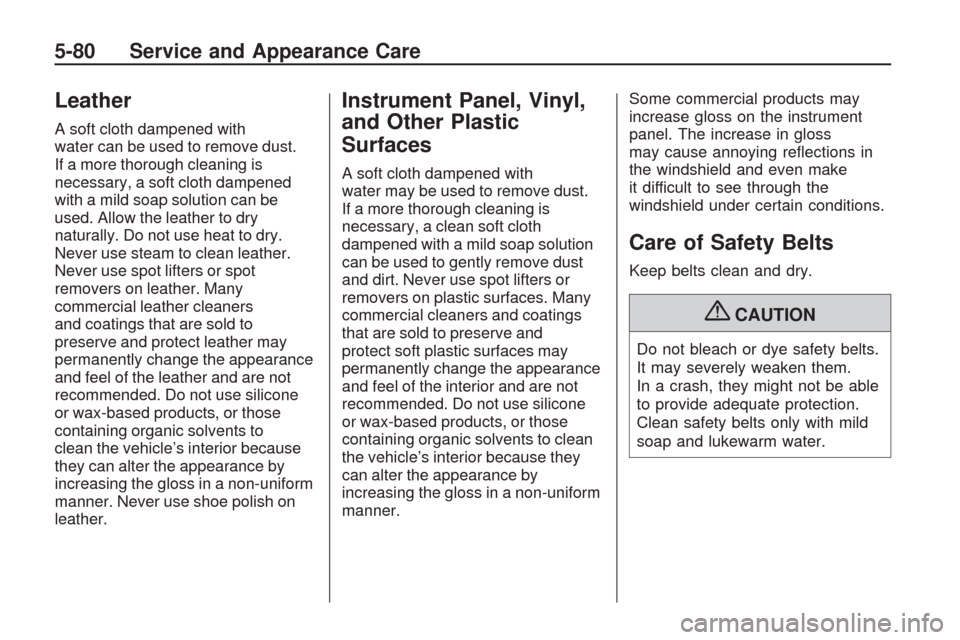
Leather
A soft cloth dampened with
water can be used to remove dust.
If a more thorough cleaning is
necessary, a soft cloth dampened
with a mild soap solution can be
used. Allow the leather to dry
naturally. Do not use heat to dry.
Never use steam to clean leather.
Never use spot lifters or spot
removers on leather. Many
commercial leather cleaners
and coatings that are sold to
preserve and protect leather may
permanently change the appearance
and feel of the leather and are not
recommended. Do not use silicone
or wax-based products, or those
containing organic solvents to
clean the vehicle’s interior because
they can alter the appearance by
increasing the gloss in a non-uniform
manner. Never use shoe polish on
leather.
Instrument Panel, Vinyl,
and Other Plastic
Surfaces
A soft cloth dampened with
water may be used to remove dust.
If a more thorough cleaning is
necessary, a clean soft cloth
dampened with a mild soap solution
can be used to gently remove dust
and dirt. Never use spot lifters or
removers on plastic surfaces. Many
commercial cleaners and coatings
that are sold to preserve and
protect soft plastic surfaces may
permanently change the appearance
and feel of the interior and are not
recommended. Do not use silicone
or wax-based products, or those
containing organic solvents to clean
the vehicle’s interior because they
can alter the appearance by
increasing the gloss in a non-uniform
manner.Some commercial products may
increase gloss on the instrument
panel. The increase in gloss
may cause annoying re�ections in
the windshield and even make
it difficult to see through the
windshield under certain conditions.
Care of Safety Belts
Keep belts clean and dry.
{CAUTION
Do not bleach or dye safety belts.
It may severely weaken them.
In a crash, they might not be able
to provide adequate protection.
Clean safety belts only with mild
soap and lukewarm water.
5-80 Service and Appearance Care
Page 367 of 422
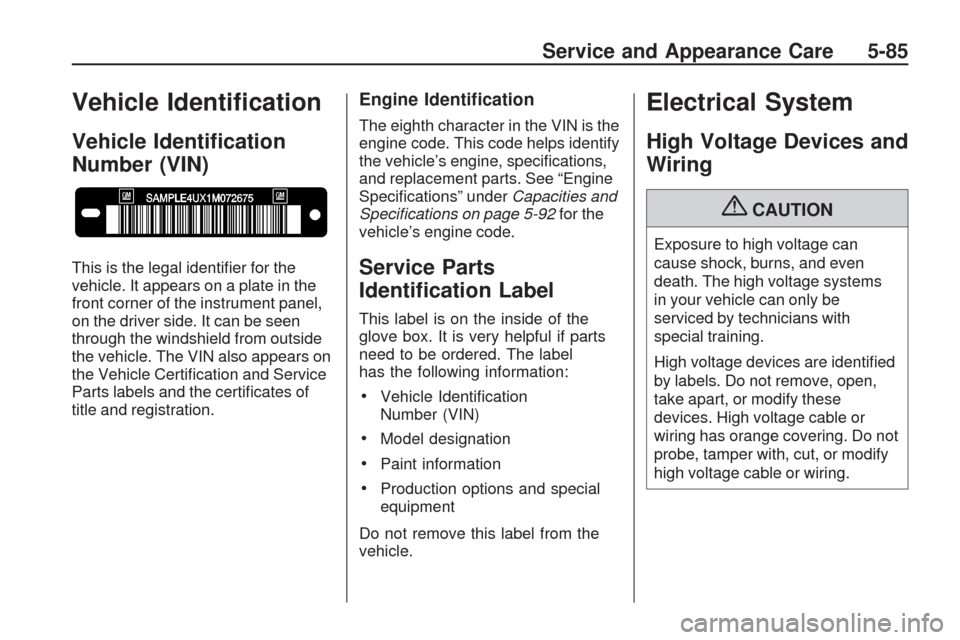
Vehicle Identi�cation
Vehicle Identi�cation
Number (VIN)
This is the legal identi�er for the
vehicle. It appears on a plate in the
front corner of the instrument panel,
on the driver side. It can be seen
through the windshield from outside
the vehicle. The VIN also appears on
the Vehicle Certi�cation and Service
Parts labels and the certi�cates of
title and registration.
Engine Identi�cation
The eighth character in the VIN is the
engine code. This code helps identify
the vehicle’s engine, speci�cations,
and replacement parts. See “Engine
Speci�cations” underCapacities and
Specifications on page 5-92for the
vehicle’s engine code.
Service Parts
Identi�cation Label
This label is on the inside of the
glove box. It is very helpful if parts
need to be ordered. The label
has the following information:
Vehicle Identi�cation
Number (VIN)
Model designation
Paint information
Production options and special
equipment
Do not remove this label from the
vehicle.
Electrical System
High Voltage Devices and
Wiring
{CAUTION
Exposure to high voltage can
cause shock, burns, and even
death. The high voltage systems
in your vehicle can only be
serviced by technicians with
special training.
High voltage devices are identi�ed
by labels. Do not remove, open,
take apart, or modify these
devices. High voltage cable or
wiring has orange covering. Do not
probe, tamper with, cut, or modify
high voltage cable or wiring.
Service and Appearance Care 5-85
Page 368 of 422
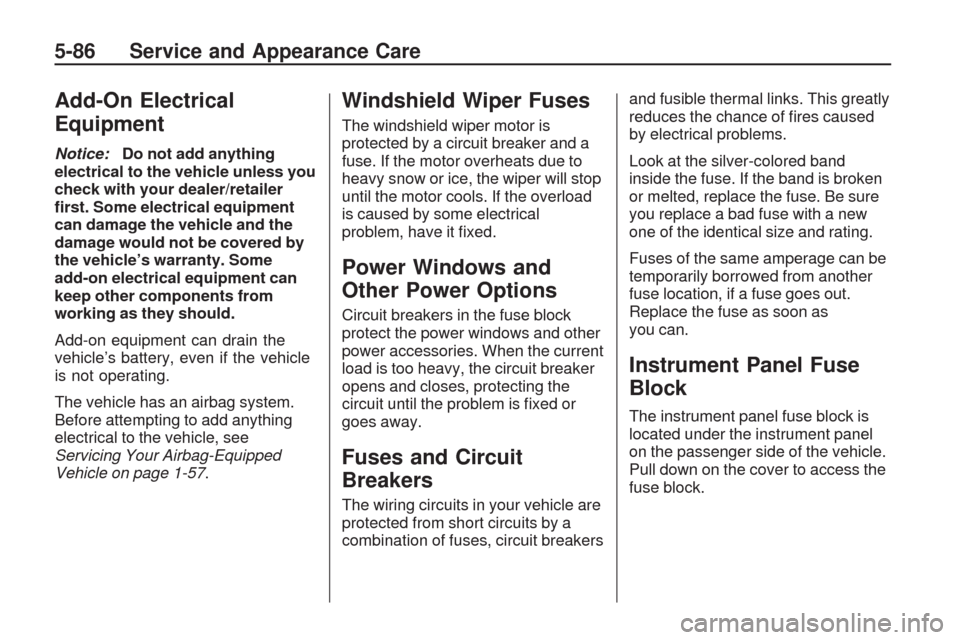
Add-On Electrical
Equipment
Notice:Do not add anything
electrical to the vehicle unless you
check with your dealer/retailer
�rst. Some electrical equipment
can damage the vehicle and the
damage would not be covered by
the vehicle’s warranty. Some
add-on electrical equipment can
keep other components from
working as they should.
Add-on equipment can drain the
vehicle’s battery, even if the vehicle
is not operating.
The vehicle has an airbag system.
Before attempting to add anything
electrical to the vehicle, see
Servicing Your Airbag-Equipped
Vehicle on page 1-57.
Windshield Wiper Fuses
The windshield wiper motor is
protected by a circuit breaker and a
fuse. If the motor overheats due to
heavy snow or ice, the wiper will stop
until the motor cools. If the overload
is caused by some electrical
problem, have it �xed.
Power Windows and
Other Power Options
Circuit breakers in the fuse block
protect the power windows and other
power accessories. When the current
load is too heavy, the circuit breaker
opens and closes, protecting the
circuit until the problem is �xed or
goes away.
Fuses and Circuit
Breakers
The wiring circuits in your vehicle are
protected from short circuits by a
combination of fuses, circuit breakersand fusible thermal links. This greatly
reduces the chance of �res caused
by electrical problems.
Look at the silver-colored band
inside the fuse. If the band is broken
or melted, replace the fuse. Be sure
you replace a bad fuse with a new
one of the identical size and rating.
Fuses of the same amperage can be
temporarily borrowed from another
fuse location, if a fuse goes out.
Replace the fuse as soon as
you can.
Instrument Panel Fuse
Block
The instrument panel fuse block is
located under the instrument panel
on the passenger side of the vehicle.
Pull down on the cover to access the
fuse block.
5-86 Service and Appearance Care
Page 394 of 422
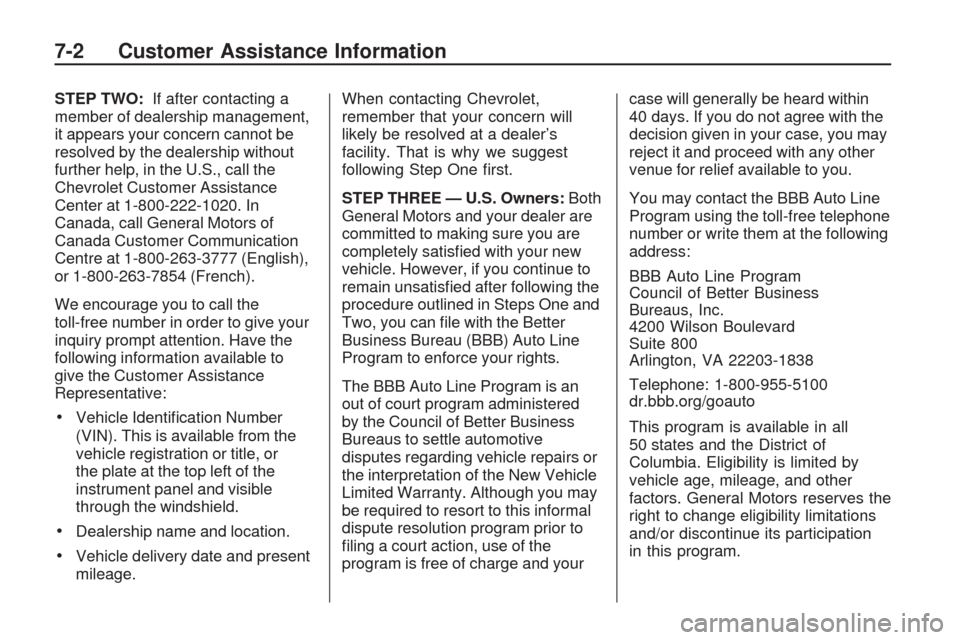
STEP TWO:If after contacting a
member of dealership management,
it appears your concern cannot be
resolved by the dealership without
further help, in the U.S., call the
Chevrolet Customer Assistance
Center at 1-800-222-1020. In
Canada, call General Motors of
Canada Customer Communication
Centre at 1-800-263-3777 (English),
or 1-800-263-7854 (French).
We encourage you to call the
toll-free number in order to give your
inquiry prompt attention. Have the
following information available to
give the Customer Assistance
Representative:
Vehicle Identi�cation Number
(VIN). This is available from the
vehicle registration or title, or
the plate at the top left of the
instrument panel and visible
through the windshield.
Dealership name and location.
Vehicle delivery date and present
mileage.When contacting Chevrolet,
remember that your concern will
likely be resolved at a dealer’s
facility. That is why we suggest
following Step One �rst.
STEP THREE — U.S. Owners:Both
General Motors and your dealer are
committed to making sure you are
completely satis�ed with your new
vehicle. However, if you continue to
remain unsatis�ed after following the
procedure outlined in Steps One and
Two, you can �le with the Better
Business Bureau (BBB) Auto Line
Program to enforce your rights.
The BBB Auto Line Program is an
out of court program administered
by the Council of Better Business
Bureaus to settle automotive
disputes regarding vehicle repairs or
the interpretation of the New Vehicle
Limited Warranty. Although you may
be required to resort to this informal
dispute resolution program prior to
�ling a court action, use of the
program is free of charge and yourcase will generally be heard within
40 days. If you do not agree with the
decision given in your case, you may
reject it and proceed with any other
venue for relief available to you.
You may contact the BBB Auto Line
Program using the toll-free telephone
number or write them at the following
address:
BBB Auto Line Program
Council of Better Business
Bureaus, Inc.
4200 Wilson Boulevard
Suite 800
Arlington, VA 22203-1838
Telephone: 1-800-955-5100
dr.bbb.org/goauto
This program is available in all
50 states and the District of
Columbia. Eligibility is limited by
vehicle age, mileage, and other
factors. General Motors reserves the
right to change eligibility limitations
and/or discontinue its participation
in this program.
7-2 Customer Assistance Information
Page 411 of 422

A
Accessories and
Modi�cations...................... 5-3
Accessory Power.................2-22
Accessory Power Outlets......3-17
Adding Equipment to Your
Airbag-Equipped Vehicle....1-58
Additional Required Services,
Scheduled Maintenance....... 6-6
Additives, Fuel...................... 5-5
Add-On Electrical
Equipment.......................5-86
Air Cleaner/Filter, Engine.......5-15
Air Conditioning...................3-19
Airbag
Readiness Light................3-33
Airbag System.....................1-46
Adding Equipment to
Your Airbag-Equipped
Vehicle........................1-58
How Does an Airbag
Restrain?.....................1-51
Passenger Sensing
System........................1-53
Servicing Your
Airbag-Equipped
Vehicle........................1-57Airbag System (cont.)
What Makes an Airbag
In�ate?........................1-51
What Will You See After
an Airbag In�ates?........1-51
When Should an Airbag
In�ate?........................1-49
Where Are the Airbags?.....1-48
Airbags
Passenger Status
Indicator.......................3-33
All-Wheel-Drive (AWD)
System............................. 4-7
Antilock Brake System (ABS) . . . 4-4
Warning Light...................3-37
Appearance Care
Aluminum or
Chrome-Plated Wheels . . . 5-83
Care of Safety Belts..........5-80
Chemical Paint Spotting.....5-84
Cleaning Exterior
Lamps/Lenses...............5-81
Fabric/Carpet...................5-79
Finish Care......................5-81
Finish Damage.................5-84
Instrument Panel, Vinyl,
and Other Plastic
Surfaces......................5-80Appearance Care (cont.)
Interior Cleaning...............5-78
Leather...........................5-80
Sheet Metal Damage........5-84
Tires...............................5-83
Underbody Maintenance....5-84
Washing Your Vehicle........5-81
Weatherstrips...................5-81
Windshield, Backglass,
and Wiper Blades..........5-82
Assistance Program,
Roadside.......................... 7-6
Audio System......................3-73
Audio Steering Wheel
Controls.....................3-125
Navigation/Radio
System, see
Navigation Manual.......3-103
Setting the Clock..............3-74
Audio System(s)..................3-75
Audio Systems
Radio Reception.............3-126
Rear Seat (RSA).............3-123
Theft-Deterrent Feature....3-125
Automatic Transmission
Fluid...............................5-16
Operation........................2-24
INDEX i-1
Page 413 of 422
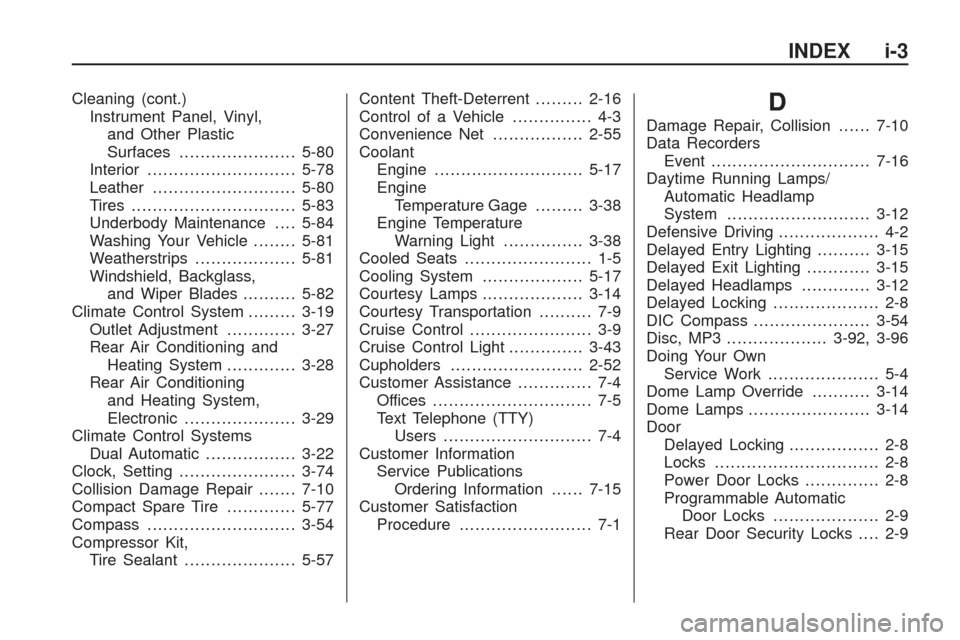
Cleaning (cont.)
Instrument Panel, Vinyl,
and Other Plastic
Surfaces......................5-80
Interior............................5-78
Leather...........................5-80
Tires...............................5-83
Underbody Maintenance....5-84
Washing Your Vehicle........5-81
Weatherstrips...................5-81
Windshield, Backglass,
and Wiper Blades..........5-82
Climate Control System.........3-19
Outlet Adjustment.............3-27
Rear Air Conditioning and
Heating System.............3-28
Rear Air Conditioning
and Heating System,
Electronic.....................3-29
Climate Control Systems
Dual Automatic.................3-22
Clock, Setting......................3-74
Collision Damage Repair.......7-10
Compact Spare Tire.............5-77
Compass............................3-54
Compressor Kit,
Tire Sealant.....................5-57Content Theft-Deterrent.........2-16
Control of a Vehicle............... 4-3
Convenience Net.................2-55
Coolant
Engine............................5-17
Engine
Temperature Gage.........3-38
Engine Temperature
Warning Light...............3-38
Cooled Seats........................ 1-5
Cooling System...................5-17
Courtesy Lamps...................3-14
Courtesy Transportation.......... 7-9
Cruise Control....................... 3-9
Cruise Control Light..............3-43
Cupholders.........................2-52
Customer Assistance.............. 7-4
Offices.............................. 7-5
Text Telephone (TTY)
Users............................ 7-4
Customer Information
Service Publications
Ordering Information......7-15
Customer Satisfaction
Procedure......................... 7-1
D
Damage Repair, Collision......7-10
Data Recorders
Event..............................7-16
Daytime Running Lamps/
Automatic Headlamp
System...........................3-12
Defensive Driving................... 4-2
Delayed Entry Lighting..........3-15
Delayed Exit Lighting............3-15
Delayed Headlamps.............3-12
Delayed Locking.................... 2-8
DIC Compass......................3-54
Disc, MP3...................3-92, 3-96
Doing Your Own
Service Work..................... 5-4
Dome Lamp Override...........3-14
Dome Lamps .......................3-14
Door
Delayed Locking................. 2-8
Locks............................... 2-8
Power Door Locks.............. 2-8
Programmable Automatic
Door Locks.................... 2-9
Rear Door Security Locks.... 2-9
INDEX i-3